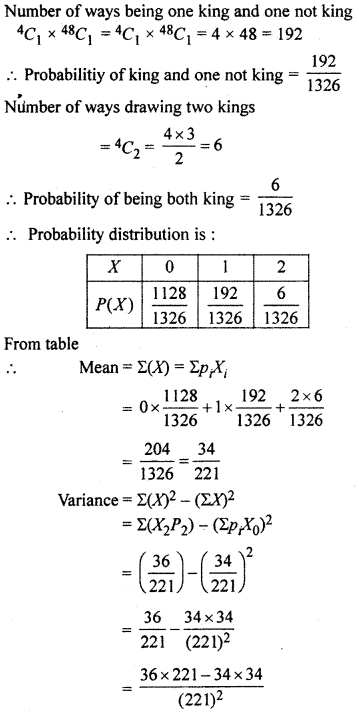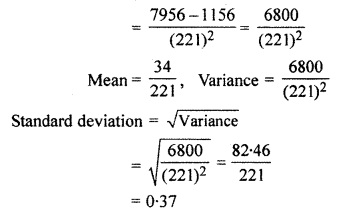Rajasthan Board RBSE Class 12 Maths Chapter 16 Probability and Probability Distribution Ex 16.4
Question 1.
Find which of the following probability distribution is possible for a random variable :
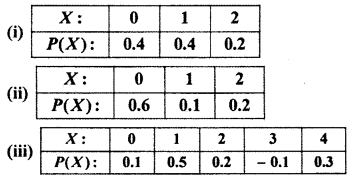
Solution:
(i) Sum of probabilities
= 0.4 + 0.4 + 0.2 = 1
Hence, given distribution is a probability distribution.
(ii) Sum of probabilities = 0.6 + 0.1 + 0.2
= 0.9 ≠ 1
Hence, the given distribution is not a probability distribution.
(iii) Here, one of the probability is – 0.1. which is negative. Hence, this distribution is not probability distribution.
Question 2.
Find the probability distribution of X, the number of heads in a simultaneous toss of two coins.
Solution:
Possible values of X are 0, 1, or 2
Now P(X = 0) = P(No head)
= P(Tail first time and tail second time)
= P(Tail first time).P(Tail in second time)
= \(\frac { 1 }{ 2 } \) × \(\frac { 1 }{ 2 } \) = \(\frac { 1 }{ 4 } \)
= P(TH or HT) = P (TH) + P(HT)
= \(\frac { 1 }{ 4 } \) + \(\frac { 1 }{ 4 } \) = \(\frac { 1 }{ 2 } \)
P(x = 2) = P (2 Head) = P(HH) = \(\frac { 1 }{ 4 } \)
∴ Required distribution is

Question 3.
4 rotten oranges are mixed accidently with 16 good oranges. Find the probability distribution of the number of rotten oranges in a draw of two oranges.
Solution:
4 bad oranges are mixed with 16 good oranges The number of total oranges = 4 + 16 = 20
2 bad oranges are to be choosen
∴ Probability of choosing a bad orange
= \(\frac { 4 }{ 20 } \) = \(\frac { 1 }{ 5 } \)
∴ Probability of choosing one good orange
= 1 – \(\frac { 1 }{ 5 } \) = \(\frac { 4 }{ 5 } \)
∵ X is the number of bad oranges
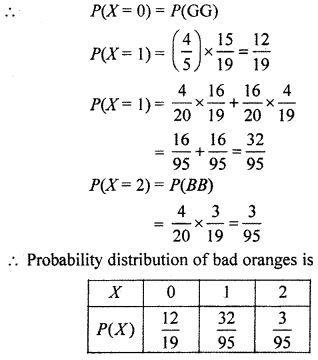
Question 4.
An urn contains 4 white and 3 red bails. Find the probability distribution of the number of red balls if 3 balls are drawn at random.
Solution:
Three balls are taken out of an urn
∴ Sample space is
= S {RRR, RRW, RWR, WRR, RWW WRW, WWR WWW}
Where R respresents red ball and W, white ball.
Let X = number of red balls. So possible value of X are 3,2,1,2,1,0 or 0, 1,2, 3 (No red ball)
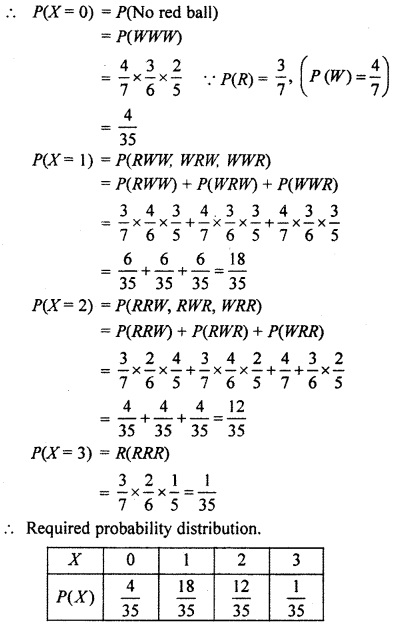
Question 5.
From a lot of 10 items containing 3 defectives, a sample of 4 items is drawn at random. Let the random variable X denote the number of defective items in the sample. If the sample is drawn randomly, find
(i) The probability distribution of X
(ii) P(x ≤ 1)
(iii) P(x < 1)
(iv) P(0 < x < 2)
Solution:
Given, from a lot of 10 items, 3 are defective
∴ Good items = 10 – 3 = 7
Let x represents the number of defective items.
Clearly values of X are 0, 1,2, 3.
P(x = 0) = P(GGGG)
= p (good items)
= \(\frac { 7 }{ 10 } \) × \(\frac { 6 }{ 9 } \) × \(\frac { 5 }{ 8 } \) × \(\frac { 4 }{ 7 } \) = \(\frac { 1 }{ 6 } \)
P (x = 1) = P (one good and three defective)
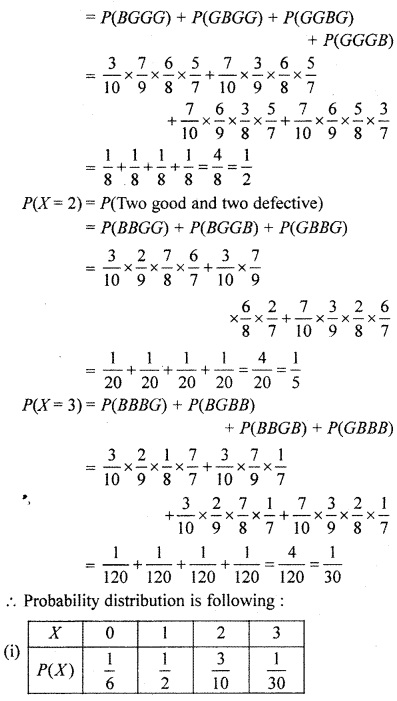
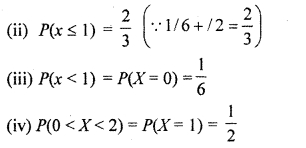
Question 6.
A die is manufactured in such a way that an even number is twice likely to occur as an odd number. If the die is tossed twice, find the probability distribution of the random variable X representing the perfect square in the two tosses.
Solution:
Let X represents the number of perfect squares.
S = sample space = { 1, 2, 3. 4, 5, 6}
∴ n(S) 6
n(X) = Possible number of perfect squares = {1,4} = 2
∴ Probability of getting perfect square
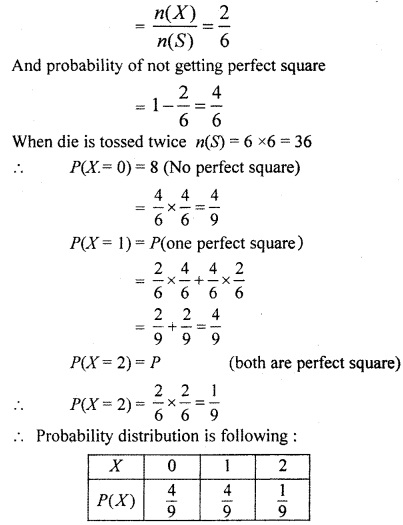
Question 7.
An urn contains 4 white and 6 red balls. Four balls are drawn at random from the urn. Find the probability of the number of white balls.
Solution:
Let X represents white balls.
∴ Total balls =4 + 6 = 10
Four balls are drawn at random.
∴ Expected values of X will be 0,1,2,3,4.
∴ P(X = 0) = P(all red)
= P(RRRR)
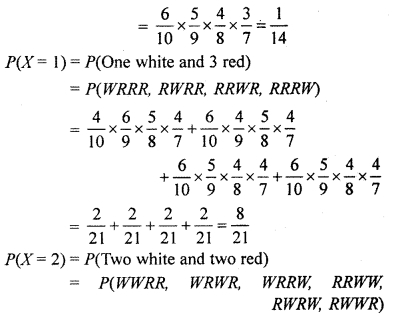
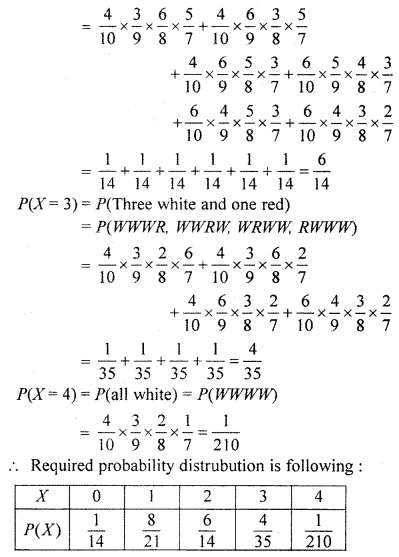
Question 8.
Find the probability distribution of number doublets in three throws of a pair of dice.
Solution:
Let x = number of doublets
∴ Expected value of x will be 0, 1, 2, 3
Set of all doublets available on a pair of dice in a throw = (1,1), (2, 2), (3,3), (4,4), (5, 5), (6, 6)
Number of all possible ways on throwing a pair of dice. = 6 × 6 = 36
∴ Probablity of getting a doublets on a pair of dice in a throw = \(\frac { 6 }{ 36 } \) = \(\frac { 1 }{ 6 } \)
∴ Probablity of getting a doublets on a pair of dice throw = 1 – \(\frac { 1 }{ 6 } \) = \(\frac { 5 }{ 6 } \)
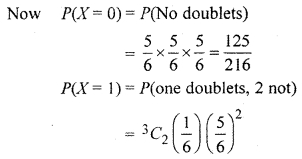
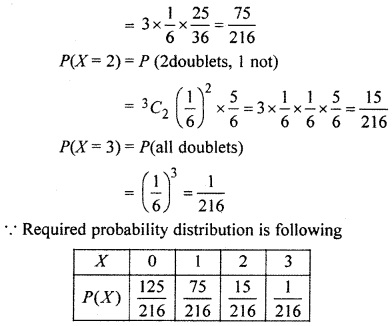
Question 9.
Let a pair of dice be thrown and the random variable X be the sum of the numbers that appear on the two dice. Find the mean of X.
Solution:
The number of possible outcomes when two dice are thrown = 6 × 6 = 36
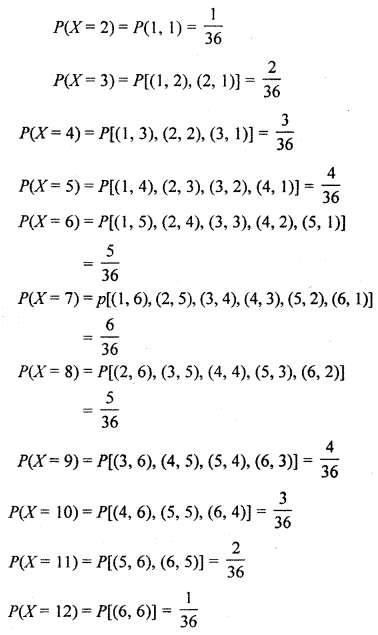
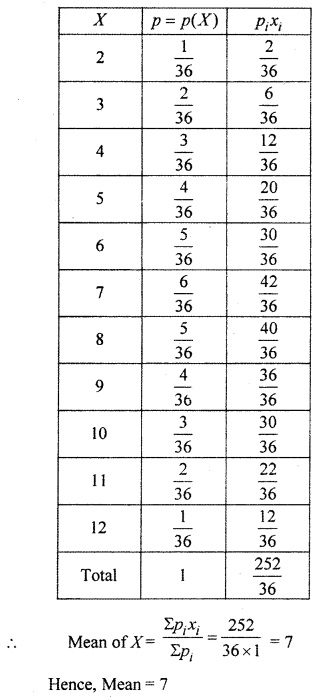
Question 10.
Find the variance of the number obtained on a throw of an unbiased die.
Solution:
Let sample space of observation be s = {1,2, 3, 4, 5, 6}
X represents the number appeared on dice. Then x is a random variable takes value 1, 2, 3,4, 5 or 6.
Also P(1) = P(2) = P(3) = P(4) = P(5) = P(6) = \(\frac { 1 }{ 6 } \)
∴ Probablity distribution is Following:
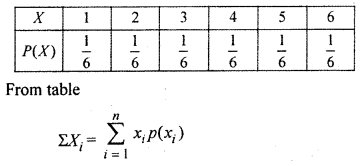
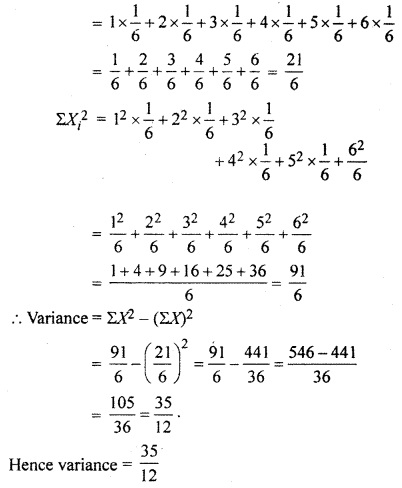
Question 11.
In a meeting, 70% of the members favour and 30% oppose a certain proposal. A member is selected at random and we take X = 0 if he opposed, and X = 1 if he is in favour. Find the mean and variance of X.
Solution:
Probability of members, favouring any proposal on X = 1
70% = \(\frac { 70 }{ 100 } \) = 0.70
Probability of members, opposing any proposal on X= 0
30% = \(\frac { 30 }{ 100 } \) = 0.30
∴ Required probability distribution is following
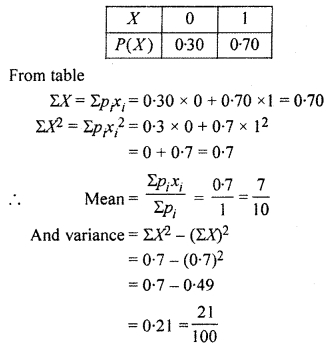

Question 12.
Two card are drawn simultaneously (or successively without replacement) from a well shuffled pack of 52 cards. Find the mean, variance and standard deviation of the number of kings.
Solution:
Two cards are drawn
∴ Number of ways that two cards are not king.

Number of ways of drawing two cards out of 52 cards = 52C2

∴ Probability of not drawing any king = \(\frac { 1128 }{ 1326 } \)
